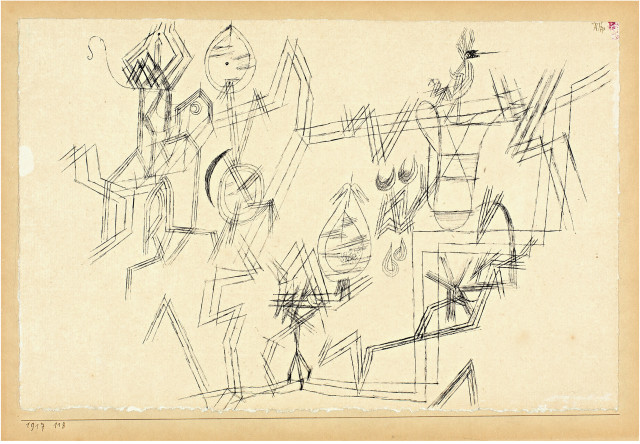- EN
Log in
- Live Auctions
- Past auctions
- More
- Gallery
- Art Dealing
- Publishing
- Kornfeld today
- The Story of Kornfeld
- Information



Münchenbuchsee bei Bern 1879 - 1940 Muralto
1917 - work number 1917.118
Pen and Indian ink on paper, laid down by the artist on a support
16.4x24.3 cm, overlaid paper. end line and writing; 23.8x24.5 cm, underlay cardboard
Signed "Klee" by the artist in pen and Indian ink in the extreme upper right corner, with the date and work number "1917 118" on the underpacking sheet on the left below the end line.
Catalogue raisonné, Paul Klee, Volume 2, Werke 1913-1918, Bern 2000, no. 1802
Gallery New Art, Hans Goltz, Munich
Klipstein and Kornfeld Gallery, Bern
John Torson, New York
Harvey S. Lubitz, New York
Auction Sotheby's, London, 11 May 1988, lot 136
Auction Sotheby's, London, 27 June 1990, lot 357
John Berggruen Gallery, San Francisco
Auction Villa Grisebach, Berlin, 30 November 1996, lot 250
Auction Christie's, London, 11 February 2011, purchased there for
Private collection Germany
Christian Geelhaar, Klee-Zeichnungen. Reise ins Land der besseren Erkenntnis, Cologne 1975, Fig. 42.
Constance Naubert-Riser, La Création chez Paul Klee, Paris/Ottawa 1978, pag. 101
Munich 1920, Galerie Neue Kunst, Hans Goltz, Paul Klee, cat. no. 320
Cologne 1979, Kunsthalle, Paul Klee, Das Werk der Jahre 1919-1933, cat. no. 7, reprod.
The drawing on laid paper, mounted on a brownish wove paper (papier vélin), with a slight light margin (mat burn) on the backing sheet. On the drawing sheet in the margin on the left small white colour spot. With traces of old hinges on the back
During the First World War, Klee was drafted into the Bavarian army as a Landsturm soldier. On the day of his enlistment he learned of the death of his friend Franz Marc at Verdun; his friend August Macke had already been killed on the Western Front shortly after the war began. In 1917 he was transferred to the Fliegerschule V in Gersthofen, where he worked as a clerk to the treasurer. He was thus spared a frontline mission and could continue to devote himself to his art in a logis outside the barracks. In February 1917, Herwarth Walden showed the second exhibition of Klee's works at the Sturm gallery, which greatly contributed to his artistic and commercial breakthrough. In addition to paintings, he also produced many ink drawings during his time in Gersthofen, such as this charming sheet. It is a composition that tends towards the surreal: a striking bird in the upper right-hand corner, with vegetal formations visible further on. In between are wildly jagged lines that can probably be interpreted as the bird's flight path. Klee thus makes the path, i.e. the "in-between", the subject on which the actual, i.e. metaphysical "being" of the bird is based
1917 - Werknummer 1917.118
Feder in Tusche auf Papier, vom Künstler auf Unterlage aufgelegt
16,4x24,3 cm, aufgelegtes Papier, Abschlussstrich und Schrift; 23,8x24,5 cm, Unterlagekarton
Oben rechts in der äussersten Ecke vom Künstler in Feder in Tusche signiert "Klee", auf dem Unterlagebogen links unterhalb des Abschlussstriches mit Datum und Werknummer "1917 118"
Catalogue raisonné, Paul Klee, Band 2, Werke 1913-1918, Bern 2000,
Galerie Neue Kunst, Hans Goltz, München
Galerie Klipstein und Kornfeld, Bern
John Torson, New York
Harvey
Auktion Sotheby's, London, 11. Mai 1988, Los 136
Auktion Sotheby's, London, 27. Juni 1990, Los 357
John Berggruen Gallery, San Francisco
Auktion Villa Grisebach, Berlin, 30. November 1996, Los 250
Auktion Christie's, London, 11. Februar 2011, dort angekauft für
Privatsammlung Deutschland
Christian Geelhaar, Klee-Zeichnungen. Reise ins Land der besseren Erkenntnis, Köln 1975,
Constance Naubert-Riser, La Création chez Paul Klee, Paris/Ottawa 1978, pag. 101
München 1920, Galerie Neue Kunst, Hans Goltz, Paul Klee,
Köln 1979, Kunsthalle, Paul Klee, Das Werk der Jahre 1919-1933,
Die Zeichnung auf Büttenpapier, aufgelegt auf ein bräunliches Velin, mit einem leichten Lichtrand auf dem Unterlagebogen. Auf dem Zeichnungsbogen im Rand links kleiner weisser Farbfleck. Rückseitig mit Spuren von alten Scharnieren
Während des Ersten Weltkriegs wurde Klee als Landsturmsoldat zur bayerischen Armee aufgeboten. Am Tag seiner Einberufung erfuhr er vom Tod seines Freundes Franz Marc bei Verdun; bereits sein Freund August Macke ist kurz nach Kriegsbeginn an der Westfront gefallen. 1917 wurde er an die Fliegerschule V nach Gersthofen versetzt, wo er als Schreiber des Kassenwarts tätig war. Es blieb ihm dadurch ein Fronteinsatz erspart, und er konnte sich in einem ausserhalb der Kaserne gelegenen Logis weiterhin seiner Kunst widmen. Im Februar 1917 zeigte Herwarth Walden die zweite Ausstellung mit Klees Werken in der Galerie "Sturm", was stark zum künstlerischen und kommerziellen Durchbruch beitrug. Neben Malerei entstanden in der Zeit in Gersthofen auch viele Tuschezeichnungen, wie das vorliegende, reizvolle Blatt. Es ist eine ins Surreale neigende Komposition: oben rechts ein markanter Vogel, weiter zu erkennen vegetabile Gebilde. Dazwischen verlaufen wild gezackte Striche, die wohl als Flugbahn des Vogels gedeutet werden können. Klee macht so den Weg, also das "Dazwischen", zum Thema, auf welchem das eigentliche, also metaphysische "Sein" des Vogels beruht




